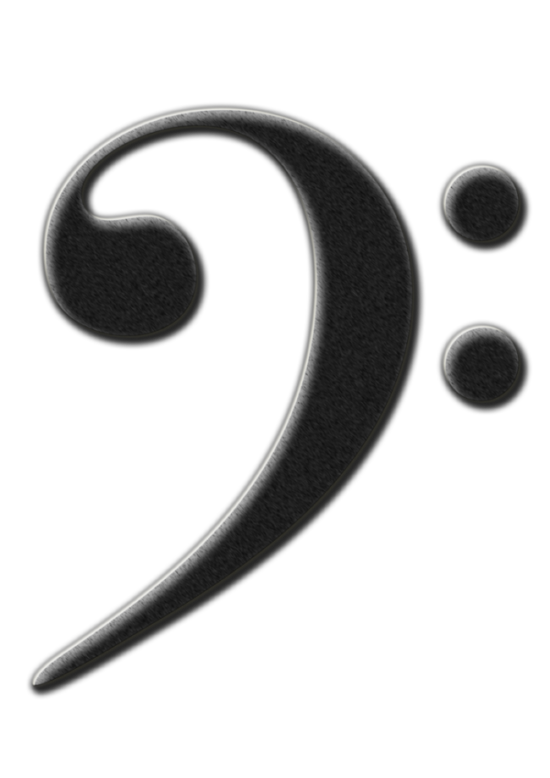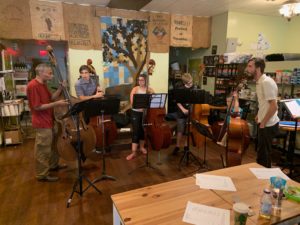
2019 Summer Bass Study Camp Recap
This last week I wrapped up the second annual Summer Study Bass Camp. The camp was created last summer to reach young bassists in my community who are interested in learning more about playing the bass, connecting with other young bassists, and furthering their playing throughout the summer months.
This summer I had the pleasure of teaching four young double bassists ranging in age and experience. All of the students received one weekly hour long private lesson beginning in July. Our time concluded with a performance at the Treehouse Cafe, a local cafe, to showcase the students growth and hard work. The day before the performance the students and I met for two and a half hours to collaborate and rehearse the music for the performance.
Teaching Points, Student Experience, and Music
Throughout our time together, the students and I addressed all aspects of playing the bass in lesson. We worked on posture, left hand technique, right hand technique, intonation, tone production, rhythm and feel, and expression. We worked on scales and finger patterns and I tried to give the students a solid foundation so that when our time was up, they would leave the program with some enduring concepts on how to play the bass. The students worked on several folk songs from the George Vance Progressive Repertoire volumes. The materials found in Vance’s volumes work so well because he wove in essential technical aspects of playing the bass while also addressing musicality and expression.
I wanted to expose the students to Vance’s material, especially the earlier pieces, to give the students a solid foundation and left hand concept. Vance starts students them in what he calls, 3rd position, which is exciting for students because they generally have never played higher than a D above the staff before. This places the students at the heel of the bass with the thumb at the heel of the bass and the first finger parallel to the thumb. Even if the students had been playing for a longer period of time, I reviewed this concept with them and worked with them on some of his earlier pieces from the series to reinforce a solid left hand technique and shape that seems to come more naturally when you start students at the heel of the bass.
From this point, I worked with the students on some of the other folk songs in first position to help reinforce their knowledge, intonation, and pitch in first position. We also addressed shifting between both first position and third position. As we worked on each short piece we addressed tone production, articulation, and musicality.
Additionally, the students worked on two pieces I arranged for double bass ensemble. The first was a blues by the great vibraphonist Milt Jackson called “Bag’s Groove.” I arranged it a la Ray Brown and his rendition of it with John Clayton. You can check it out here. The students were able to learn the form of the blues, play the melody, begin to develop a jazz rhythmic concept, and further cultivate a pizzicato sound. The second arrangement was of the Richard Meyers orchestral classic, “Dragon Hunter.” This piece is very rhythmic and exciting, set in a minor mode, it tries to imagine the suspense and adventure of a dragon hunter.
Final Performance and Workshop Recap
Our study time concluded with a final performance at the Treehouse Cafe, a local coffee shop that does a lot for the community. The performance also featured special guest Mike Boone, a veteran bassist, educator, mentor, and friend. As a part of the students experience I wanted them to be exposed to a world class musician and educator and have the opportunity to experience music from another bassist as well as hear Mike and I perform together.
The concert opened with our arrangement of “Bag’s Groove.” This featured all of the students playing the melody while Mike walked a bass line underneath. Next the students performed a medley of folk songs taken from George Vance’s Progressive Repertoire for Double Bass. Three of the older students and myself performed my arrangement of “Dragon Hunter” following the folk melodies. Mike and I then performed “Tricotism” by jazz bassist Oscar Pettiford. Following our duet, Mike performed a solo rendition of Horace Silver’s tune, “Peace.” Mike made use of the bow as well as his fluid pizzicato technique. We concluded the performance with another rendition of “Bag’s Groove.”
Following the performance, Mike and I opened the night up as a workshop. Mike shared his knowledge of bass playing with the students. He walked them through playing the blues, how to begin creating bass lines over blues chord changes, and had each student play a chorus of the blues. It was inspiring to see Mike work and hear the students begin to internalize the blues and begin to develop their own bass lines.
Photo: During the workshop. The students working on the blues with special guest bassist and educator, Mike Boone
Conclusion
It was exciting to bring together young bassists in my community this summer for a time of study and music making. Last summer I was inspired by the experience and I have found myself inspired once again. I look forward to next summer and the third annual Summer Bass Study Camp.
